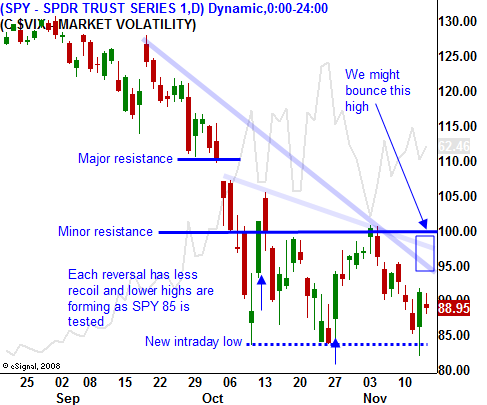G20 Won’t Change A Thing – Favor The Short Side But Don’t Be Aggressive!
Yesterday, the market drifted below key support at SPY 85 and it made a new relative low on an intraday basis. Mid-day, traders covered short positions ahead of the G20 meeting. That sparked a massive short covering rally. Unfortunately, this bear market rally will not have any legs and today, much of those gains have already been stripped away.
A market catalyst will NOT come out the G20 meeting. The world's largest economies agree that we are in a recession and that financial institutions are in dire straits. Virtually every central bank has approved a bailout and/or stimulus package of some type.
The best that we can hope for in the coming years is a gradual drift lower where the issues are resolved in an orderly manner. The worst-case scenario is obviously a financial collapse. I believe we have the global cooperation needed to avoid such a disaster.
The problem is debt and the solution is saving money to pay for that debt. Hard work and time will get us through this crisis if we learn from our mistakes.
Over the last 30 years, our savings rate as a percentage of income has dropped from 10% to zero. More than two thirds of baby boomers have less than $100,000 saved for retirement.
Household debt has increased 137% over the past decade and it now stands at $14 trillion. Credit card companies are reducing credit lines and banks are reducing home-equity loans. Last week, J.P. Morgan announced a 40% increase year-over-year on credit card defaults. This could be the next shoe to drop and banks wanted to forgive 40% of the credit card loans owed by people who did not qualify for the mortgage bailout plan. Those losses would have been swept under the “TARP” and fortunately the Fed nixed that idea.
The Fed has outlined part of its mortgage default program. About 1.4 million mortgages are currently 60-days in default and that number is expected to triple next year. Banks will renegotiate mortgages where the homeowner's monthly payment is less than 31% of their income. This number is much higher than the current threshold it was raised because Americans have so much personal debt. Analysts believe that this debt to income level is serviceable. If these renegotiated mortgages go into default, the Fed will pick up half of the tab.
Automakers are near bankruptcy. Consumers are cutting back their spending and 58% of Americans feel that they could lose their job in the next year. Car buyers with a prime credit rating were being approved for loans 90% of the time last year. That figure has fallen to 60%. Subprime purchasers were approved 60% of the time last year and now they are approved 10% of the time. The cost of a Big 3 bailout will be far more than $50B. That is just the tip of the iceberg. It takes them 5 years to re-tool and go to production. If they were able to roll the next electric car off the line tomorrow, who could get financing for it? There are oceans of cars that will go to “fire sale” in the next 6 months.
Circuit City has filed for bankruptcy and Best Buy said that these are the worst conditions it has ever seen.
Unfortunately, the Fed is in a similar situation. Our national debt has gone up 250% in the last eight years. In 10 years, the government will spend 100% of its budget on interest (national debt) and entitlement programs (Social Security, Medicare, welfare). At a time when we are trying to raise capital for our bailout, the rest of the world is trying to do the same. To date, over $4 trillion has been pledged to global bailouts and stimulus packages. With all of this supply, yields will go up and it will cost us more to borrow money. Standard & Poor's issued a warning on the AAA debt rating for the United States. A downgrade would be devastating and it would cost us much more to get out of this mess.
The unemployment rate continues to climb and that means the credit crisis will worsen.
Decades of greed and poor lending decisions will lead to huge losses. Someone has to pay and the Fed is spreading that burden out between the financial institutions and the taxpayers.
In today's chart I have highlighted a few comments. The market was not able to get through minor resistance at SPY 100 last week. Yesterday, it tested key support and we saw a huge one-day rally. Notice how each of the reversals in the chart have less recoil. That is resulting in a series of lower highs. The market is testing SPY 85 with greater frequency and I still feel that support will fail. As opposed to a major decline, I believe a gradual drift lower will set in.
I like selling put credit spreads in the energy sector and I like selling call credit spreads in consumer discretionary.


Daily Bulletin Continues...

